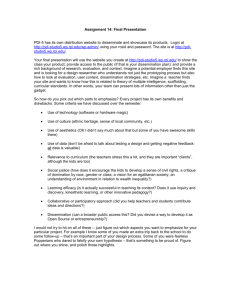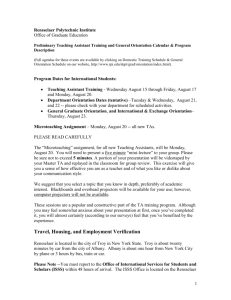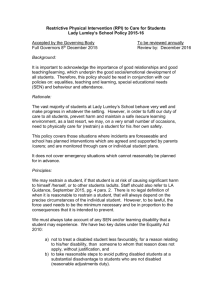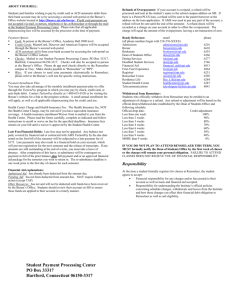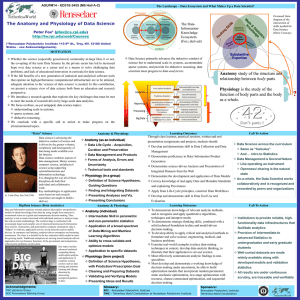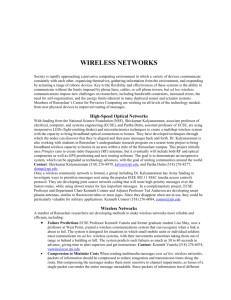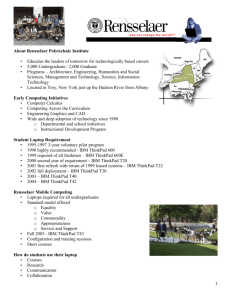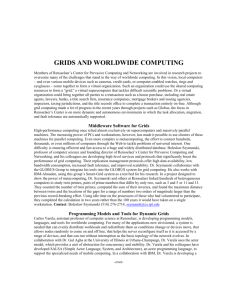Toward_Next_Generation_Health_Assistants
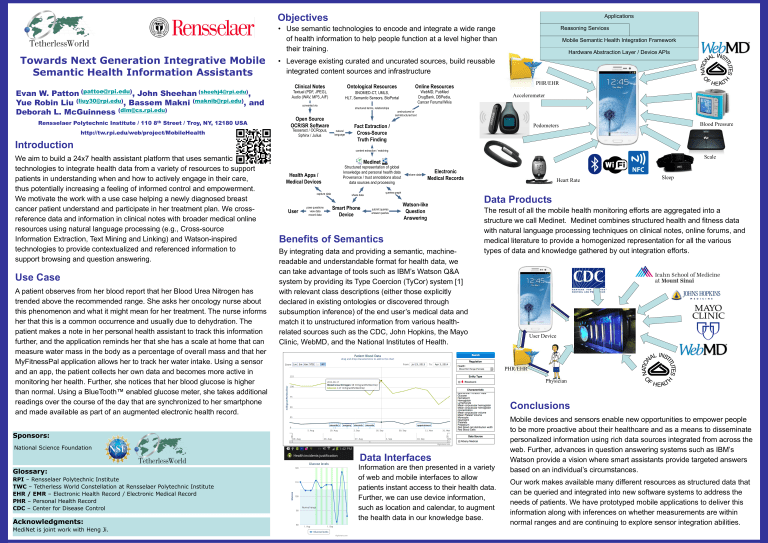
Towards Next Generation Integrative Mobile
Semantic Health Information Assistants
Objectives
• Use semantic technologies to encode and integrate a wide range of health information to help people function at a level higher than their training.
• Leverage existing curated and uncurated sources, build reusable integrated content sources and infrastructure
Evan W. Patton
(
pattoe@rpi.edu
)
, John Sheehan
( sheehj4@rpi.edu
)
,
Yue Robin Liu ( liuy30@rpi.edu
) , Bassem Makni ( maknib@rpi.edu
) , and
Deborah L. McGuinness ( dlm@cs.rpi.edu
)
Rensselaer Polytechnic Institute / 110 8
th
Street / Troy, NY, 12180 USA http://tw.rpi.edu/web/project/MobileHealth
Introduction
We aim to build a 24x7 health assistant platform that uses semantic technologies to integrate health data from a variety of resources to support patients in understanding when and how to actively engage in their care, thus potentially increasing a feeling of informed control and empowerment.
We motivate the work with a use case helping a newly diagnosed breast cancer patient understand and participate in her treatment plan. We crossreference data and information in clinical notes with broader medical online resources using natural language processing (e.g., Cross-source
Information Extraction, Text Mining and Linking) and Watson-inspired technologies to provide contextualized and referenced information to support browsing and question answering.
Use Case
A patient observes from her blood report that her Blood Urea Nitrogen has trended above the recommended range. She asks her oncology nurse about this phenomenon and what it might mean for her treatment. The nurse informs her that this is a common occurrence and usually due to dehydration. The patient makes a note in her personal health assistant to track this information further, and the application reminds her that she has a scale at home that can measure water mass in the body as a percentage of overall mass and that her
MyFitnessPal application allows her to track her water intake. Using a sensor and an app, the patient collects her own data and becomes more active in monitoring her health. Further, she notices that her blood glucose is higher than normal. Using a BlueTooth ™ enabled glucose meter, she takes additional readings over the course of the day that are synchronized to her smartphone and made available as part of an augmented electronic health record.
Clinical Notes
Textual (PDF, JPEG),
Audio (WAV, MP3, AIF) converted via
Open Source
OCR/SR Software
Tesseract / OCRopus,
Sphinx / Julius natural language
Ontological Resources
SNOMED-CT, UMLS,
HL7, Semantic Sensors, BioPortal structured terms, relationships unstructured or semistructured text
Online Resources
WebMD, PubMed
DrugBank, DBPedia,
Cancer Forums/Wikis
Fact Extraction /
Cross-Source
Truth Finding
content extraction / matching
Health Apps /
Medical Devices
User
capture data pose questions view data record data
Medinet
Structured representation of global knowledge and personal health data
Provenance / trust annotations about data sources and processing queries graph share data
Smart Phone
Device
submit queries answer queries share data
Watson-like
Question
Answering
Electronic
Medical Records
Benefits of Semantics
By integrating data and providing a semantic, machinereadable and understandable format for health data, we can take advantage of tools such as IBM’s Watson Q&A system by providing its Type Coercion (TyCor) system [1] with relevant class descriptions (either those explicitly declared in existing ontologies or discovered through subsumption inference) of the end user’s medical data and match it to unstructured information from various healthrelated sources such as the CDC, John Hopkins, the Mayo
Clinic, WebMD, and the National Institutes of Health.
PHR/EHR
Accelerometer
PHR/EHR
Pedometers
User Device
Applications
Reasoning Services
Mobile Semantic Health Integration Framework
Hardware Abstraction Layer / Device APIs
Heart Rate
Physician
Sleep
Blood Pressure
Scale
Data Products
The result of all the mobile health monitoring efforts are aggregated into a structure we call Medinet. Medinet combines structured health and fitness data with natural language processing techniques on clinical notes, online forums, and medical literature to provide a homogenized representation for all the various types of data and knowledge gathered by out integration efforts.
Sponsors:
National Science Foundation
Glossary:
RPI – Rensselaer Polytechnic Institute
TWC – Tetherless World Constellation at Rensselaer Polytechnic Institute
EHR / EMR – Electronic Health Record / Electronic Medical Record
PHR – Personal Health Record
CDC – Center for Disease Control
Acknowledgments:
MediNet is joint work with Heng Ji.
Data Interfaces
Information are then presented in a variety of web and mobile interfaces to allow patients instant access to their health data.
Further, we can use device information, such as location and calendar, to augment the health data in our knowledge base.
Conclusions
Mobile devices and sensors enable new opportunities to empower people to be more proactive about their healthcare and as a means to disseminate personalized information using rich data sources integrated from across the web. Further, advances in question answering systems such as IBM’s
Watson provide a vision where smart assistants provide targeted answers based on an individual’s circumstances.
Our work makes available many different resources as structured data that can be queried and integrated into new software systems to address the needs of patients. We have prototyped mobile applications to deliver this information along with inferences on whether measurements are within normal ranges and are continuing to explore sensor integration abilities.
